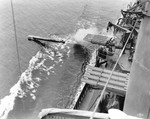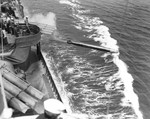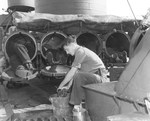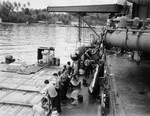Mark XV Torpedo
| Country of Origin | United States |
| Type | Torpedo |
| Diameter | 533.000 mm |
| Length | 7.315 m |
| Weight | 1742.000 kg |
| Range | 4.100 km |
| Machinery | Wet-heater combustion steam turbine with compressed air tank |
| Explosive Charge | 363 kg TNT or 373 kg HBX |
| Speed | 83.00 km/h |
Contributor: David Stubblebine
ww2dbaseThe Mark XV torpedo (or interchangeably, the Mark 15 torpedo) was the United States Navy's standard surface fired torpedo of World War II, primarily fired from destroyers and Atlanta-class light cruisers. The design process for the Mark 15 at the United States Navy's Bureau of Ordnance Naval Torpedo Factory paralleled that of the Mark 14 submarine torpedo which started in Jan 1931. The Mark 15 was larger than the Mark 14 and was meant as a replacement for the Mark 8, which had been in service since before World War I.Several things drove the need for a new design but the primary reason was because new warships were fast enough to simply outrun the Mark 8. The Mark 15 shared many of the same basic design features as the Mark 14 as well as many of the same problems. Despite being introduced in 1935, flaws in both designs went undetected until the United States entered World War II and then persisted for another 20 months. Submarines fired many more Mark 14 torpedoes early in the war than destroyers fired Mark 15 torpedoes so the Mark 15 deficiencies were not recognized nearly as quickly; but even so, as Mark 14 problems were being solved, those solutions were applied to the Mark 15.
With torpedo tubes being withdrawn from United States battleships and most cruisers in the 1930s, United States Navy warships firing torpedoes in World War II were primarily destroyers, although the doctrine of destroyers closely screening cruisers kept destroyers from being in position to actually launch torpedoes very often. Later in the war, as surface engagements involving destroyers became even less likely, many destroyers had their torpedo tubes removed altogether. Among the earliest successful uses of the Mark 15, however, was in the Battle of Vella Gulf in the Solomon Islands in Aug 1943. In that night action, six American destroyers, aided by radar, surprised a force of four Japanese destroyers attempting to reinforce Munda on New Georgia. Careful to attack from the shadow of Kolombangara Island, United States destroyers USS Dunlap, Craven and Maury mimicked Japanese tactics by not giving away their positions with gunfire and launched a multi-ship salvo of twenty-four Mark 15 torpedoes within barely a minute. All four Japanese ships were hit and destroyers Hagikaze, Arashi, and Kawakaze burst into flames and sank. Destroyers USS Lang, Sterett, and Stack then closed from the opposite side and attacked with gunfire. The torpedo that hit the Japanese destroyer Shigure passed through her rudder without exploding and Shigure was able to escape in the dark night without delivering her troops to Munda.
Such successes in combat were rare, however, since torpedo versus torpedo surface exchanges with the Japanese would find all Allied navies completely outmatched by the vastly superior Japanese Type 93 "Long Lance" torpedo.
What was probably the Mark 15's greatest moment in the war happened totally by accident and involved three torpedoes that completely missed their targets. On 25 Oct 1944 in the Battle off Samar during the Battle of Leyte Gulf, destroyers USS Hoel and Heerman launched three torpedoes at two completely different Japanese cruisers and missed. The torpedoes then traveled beyond the intended cruisers and advanced on the flagship Yamato. The battleship had to take evasive action to avoid being hit and to get out of the way, she had to make a high-speed almost 180-degree turn to a northward heading. As the Yamato steamed north and the rest of the force moved south, the force commander aboard Yamato, Admiral Takeo Kurita, was taken so far away from the action that he effectively lost his ability to command the battle. Additionally, the distances created by Yamato's withdrawal may have reinforced Kurita's belief that he was engaging American fleet carriers and cruisers rather than escort carriers and destroyers. In The Last Stand of the Tin Can Sailors, James Hornfischer described why he believes this evasive action by Yamato, created by three torpedoes that missed, likely had a great influence on Kurita's decision to break off the engagement and withdraw the entire force, allowing him to snatch defeat from the jaws of victory in what may have been the single most pivotal surface engagement of the entire war.
The Mark 15 torpedo remained in service until 1958 with a total of 9,700 built.
Sources:
United States Navy
Naval Weapons of the World (navweaps.com)
Naval Postgraduate School, Monterey, California; Mark XIV Torpedo Case Study by David Matthews, 2011
James Hornfischer: The Last Stand of the Tin Can Sailors
The Pacific War Online Encyclopedia
Wikipedia ww2dbase
Last Major Revision: Oct 2021
Mark XV Torpedo Mapa Interativo
Photographs
 |  |  |  |
Mark XV Timeline
| 6 ago 1943 | In the Battle of Vella Gulf in the Solomon Islands, United States destroyers USS Dunlap, Craven, Maury, Lang, Sterett, and Stack, acting on intelligence gathered from Magic codebreaking intercepts, laid in wait for four Japanese destroyers on a night mission to bring troops to Munda on New Georgia. USS Dunlap, Craven, and Maury opened the attack by launching twenty-four Mark XV torpedoes in one minute. Japanese destroyers Hagikaze, Arashi, and Kawakaze were destroyed, killing 600 sailors and 900 Japanese Army passengers. Destroyer Shigure had a torpedo pass through her rudder but the ship was able to escape in the darkness. |
| 25 out 1944 | In the Battle off Samar in the Battle of Leyte Gulf, destroyers USS Hoel and Heerman launched three Mark XV torpedoes at two different Japanese cruisers and missed. The torpedoes went on to advance on the battleship Yamato, the Japanese force flagship. Yamato’s evasive action took the force commander, Admiral Takeo Kurita, so far from the action that he effectively lost his ability to command the battle and likely contributed to his ultimate decision to break off the engagement and withdraw his force. |
Você gostou deste artigo ou achou este artigo útil? Se sim, considere nos apoiar no Patreon. Qualquer valor já vai ajudar! Obrigado. Por favor, ajude-nos a divulgar o site: Fique atualizado com WW2DB: |
Pesquisar WW2DB

Notícias
- » USS Orlean's Bow Found (22 jul 2025)
- » The Emperor of Japan Planned to Honor WW2-era Japanese POWs in Mongolia (4 jul 2025)
- » US State Lawmaker John Winter Caught Using Racial Slur "Jap" and Apologized (11 jun 2025)
- » Race, Holocaust, and African-American WW2 Histories Removed from the US Naval Academy Library (7 abr 2025)
- » US Government Plans to Purge WW2 Information (17 mar 2025)
- » Ver todas as notícias
Estatísticas Atuais do Site
- » 1,180 biografias
- » 337 eventos
- » 45,098 entradas na linha do tempo
- » 1,246 navios
- » 350 modelos de aeronaves
- » 207 modelos de veículos
- » 376 modelos de armas
- » 123 documentos históricos
- » 261 instalações
- » 470 eventos
- » 28,467 fotos
- » 365 mapas
Citação Famosa da 2ª GM
"No bastard ever won a war by dying for his country. You win the war by making the other poor dumb bastard die for his country!"George Patton, 31 May 1944
Apoie-nos
Por favor, considere nos apoiar no Patreon. Mesmo R$1 por mês já faz uma grande diferença. Obrigado!
Ou, por favor, nos apoie adquirindo alguns produtos do WW2DB na TeeSpring. Obrigado!